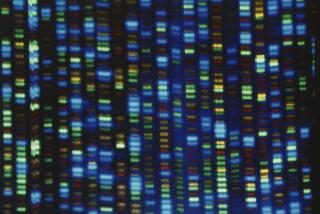Gene Project to Trace Migration
- Share via
The National Geographic Society is launching a massive project today to trace the migratory history of humans, a five-year effort that will involve the collection and analysis of DNA from more than 100,000 people around the world.
“We already have a general view of the very early Paleolithic migrations,” said geneticist Spencer Wells, a National Geographic explorer-in-residence who will lead the project. “Humans spread out of Africa, then moved out of Eurasia, but it gets very hazy after that. We’re going to nail down the details of that story.”
The Genographic Project is seeking individuals to participate in the project. They can have their DNA analyzed by buying a $99 kit that allows them to send in a swab for analysis.
Researchers will initially analyze DNA from mitochondria, the cellular powerhouses that are passed down through mothers, and the Y chromosome, which is passed by fathers.
Researchers know through several studies that all humans today received their mitochondrial DNA from one woman, or perhaps a few, living in Africa about 200,000 years ago. They call this ancestor “mitochondrial Eve,” the mother of all humans.
Similarly, researchers have traced the Y chromosome of males back to a “genetic Adam” in roughly the same time and place.
But those studies are based on data from only about 10,000 people, Wells said. The Genographic Project will have at least 10 times that many participants, allowing much greater detail to be teased out, particularly about the last 10,000 to 15,000 years.
The international team of researchers will initially concentrate on indigenous peoples, such as the Hadzabe of Tanzania, ethnic Mongolians and Navajos in the United States, all of whom have remained in one place for long periods and thus have a simpler genetic history. They will collect 10,000 DNA samples from each of 10 indigenous groups.
The team hopes a large number of individuals will participate, both to increase the funding for the project and to expand the database. Individual information, which will be posted on the Internet anonymously, could provide new insight on family history.
One sample, for example, was from a U.S. resident whose grandfather came from Germany and whose mother’s family came from England.
The DNA analysis showed a more complicated story.
According to Bennett Greenspan of Family Tree DNA, which is analyzing data for the project, the Y chromosome had a genetic profile, or haplotype, called R1a, which is believed to have originated in Northern India and Pakistan some 30,000 years ago.
Over a long period, that family migrated across Eurasia in a great arc, landing in Europe sometime after the last Ice Age. People with haplotype R1a are now found most commonly in Europe east of Germany, such as in Poland, where about 40% of the population has R1a.
Mitochondrial DNA, Greenspan said, showed a maternal lineage that traced to the Levant -- the Middle East -- and moved eventually to Europe, probably with the migration of Neolithic peoples who brought farming to the continent. People with that genetic makeup, known as haplotype K, make up no more than 9% of the population in any region.
Wells said information about the migrations will become more detailed as more people participate in the project, contributing their own genetic history. Kits may be ordered at www.nationalgeographic.com.






